Alocasia, also known as Elephant’s Ear, is stunning foliage that many people use as a centerpiece in their gardens or rooms in their homes. With heart-shaped or arrow-shaped leaves, many people (even kids!) can spot this recognizable plant from a distance.
They are often kept as indoor plants, but many people put them outside during the warmer months to help maintain the right conditions for healthy plants.
If you’re looking to get an Elephant’s Ear to add to your plant collection, there are some Alocasia care steps to follow to keep these plants healthy. Before we get into the specifics, here’s a little bit of background on these plants.
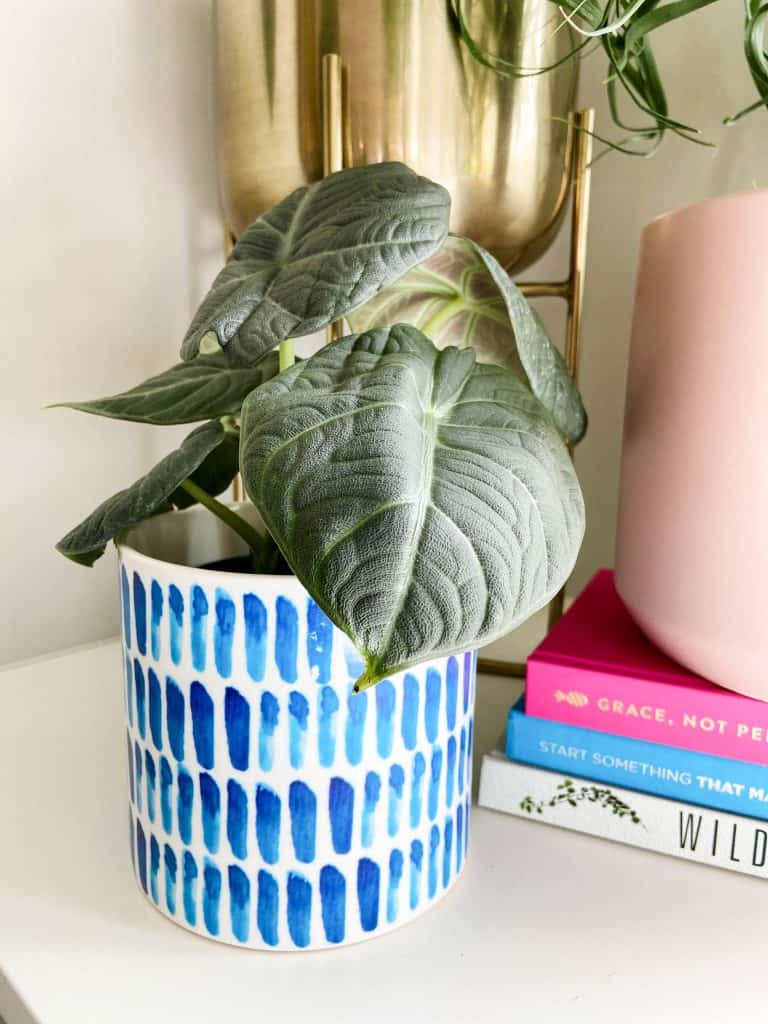
Table of Contents
Alocasia Background/History
There are more than 79 different species of Alocasia plants, and they’re mainly native to tropical and subtropical regions of the world, such as Asia and eastern Australia. They also go by the common name of African Masks.
Elephant’s Ear is a popular plant that many people around the world love. Today, they are also commonly grown in the southern regions of the United States in regions that boast tropical or humid environments perfect for this houseplant.
These beautiful tropical plants can grow up to 2 to 15 feet in height, and 2 to 8 feet in width! It is an incredibly large plant, and blooms best during the spring and the summertime. While not all of these species will bloom, the common flower colors are light butter or yellow.
Types of Alocasia

With more than 70 Alocasia species, there are dozens of hybrids as well in different options. One of the most common of the Alocasia varieties, the Kris Plant, has extremely dark foliage and an exotic look. They have long pointed leaves with white veins and scalloped leaf edges along with white outlines.
Another common variety is the Alocasia amazonica, which is a hybrid that has leathery and wavy edged leaves that are in a narrow shape. These dark bronze leaves can grow up to 16 inches long.
Another type of Alocasia, the giant taro, is an enormous plant that can grow up to 15 feet tall and 8 feet wide. Some of the leaves can reach up to 3 to 4 feet long and 2 to 4 feet wide, which is an incredible sight to see!
This is a plant that people can have in their homes, but they need appropriate space to make sure that it stays healthy and gets the appropriate amount of nutrients. This isn’t your beginner’s houseplant!
I personally own the Alocasia Polly, which you will see in the gold pot, and an Alocasia Maharani which you will see in the blue pot.
Alocasia Care Tips
Taking care of an Elephant’s Ear is not as difficult as many people believe. These plants love hot temperatures, humidity, and rich, well-draining soils. Here are some tips to make sure you take proper care of your Elephant’s Ear!
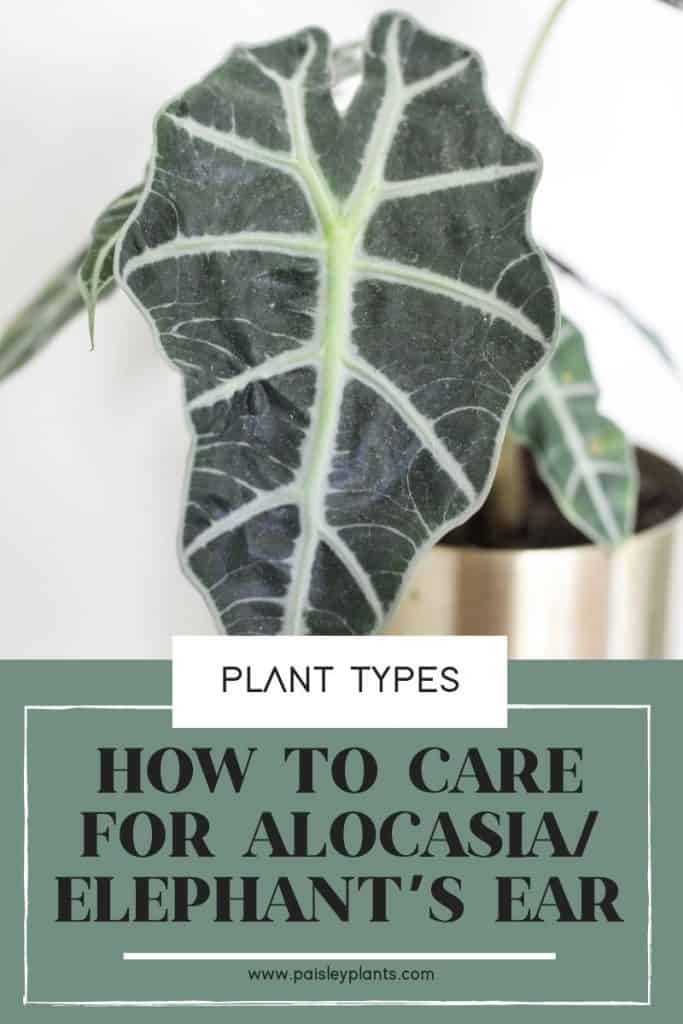
Watering
Even though this plant’s natural habitat is tropical and subtropical regions, you don’t need to water as heavily during the winter months. Watering regularly during the hotter months will help keep your plant healthy.
This plant also responds very well to misting since it’s used to high humidity. A dryer location may not be a good home for Alocasia.
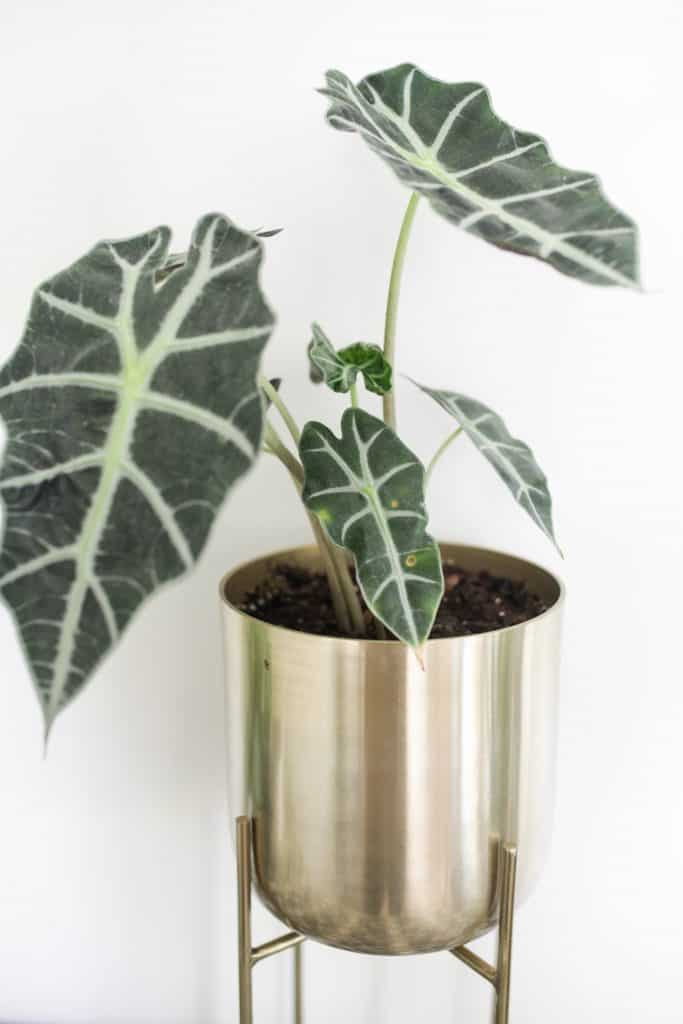
As a water-loving plant, it’s incredibly beneficial for you to continue watering as much as you need to keep the soil moist. There is, however, a difference between moist soil and soggy soil.
It’s important that you don’t cross this line! If you do, your plant might become susceptible to fungal infections, root rot, and other concerns that could likely damage the plant and its leaves.
Find my favorite watering cans here!
Light
While this plant loves tropical weather, it does not need direct sunlight all the time. It depends on the time of day and the time of year, but these plants need partial shade or full sunlight.
The lighting needed depends on the species of plant that you buy. Make sure to check the tag and ask your local gardener for more information about how to properly take care of your Alocasia.
For those who want to have a plant with more vibrancy, more light improves leaf color, but you need to be careful with how much you give. While you want to make sure it’s getting enough light, too much light can often burn the plant and damage the leaves, and this is definitely not what you want for your plant’s longevity.
Temperature & Humidity
Concerning the temperature, remember this plant is a tropical plant. It is much harder to grow this plant in temperatures below 60 degrees Fahrenheit. Some varieties will actually die if the temperature gets below this, but they will end up resprouting from their rhizomes.
As mentioned, they are water and humidity lovers. One of the best ways to help with humidity is to use a pebble tray underneath the plant. Then, add water until it rises just below the bottom of the pot.
Keeping your plant away from cold drafts, such as windows or doors or even air conditioning, will also be incredibly helpful to keep the humidity levels optimal.
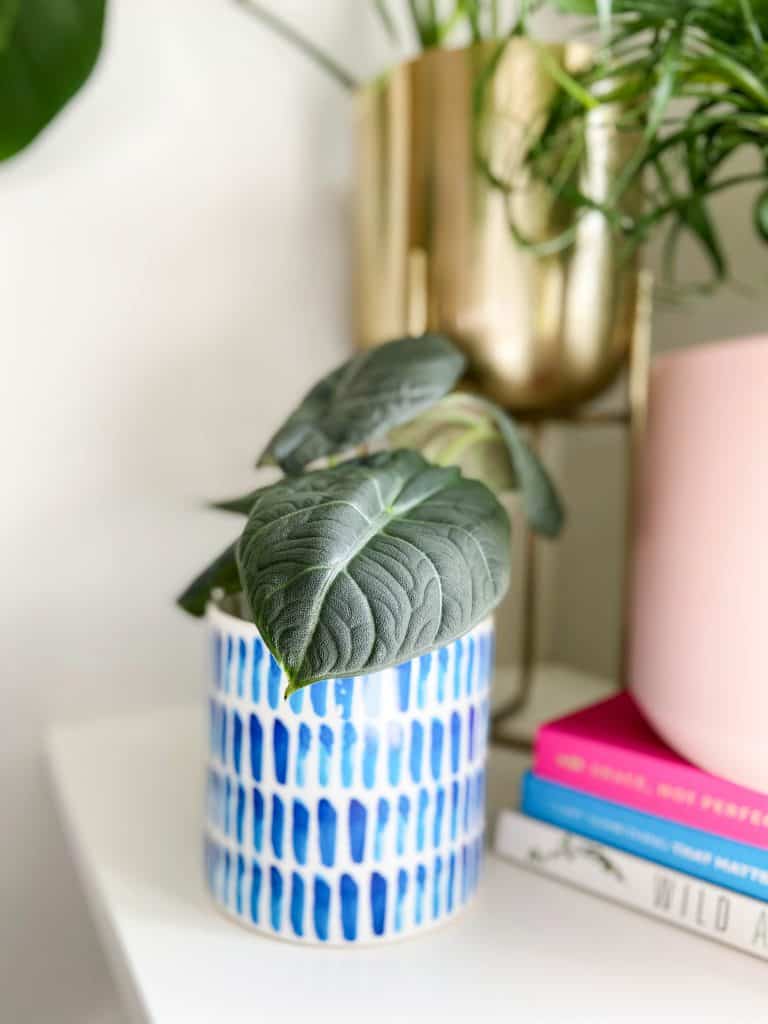
Because of the temperature needs, those who live in warmer climates do not have to worry about keeping this outside or inside. However, those who live in colder temperatures need to be more careful with their plant.
In the winter, this plant should never be outside. It should only be outside in warm months when the temperature is above 60 degrees, and the humidity is harmonious for the plant.
Soil
Because this plant is moisture-loving, you can’t have any ordinary soil. Elephant’s Ear needs to have loose, well-draining potting mix. The other option is to have crummy or loamy soil, which is beneficial for the plant and helps with moisture.
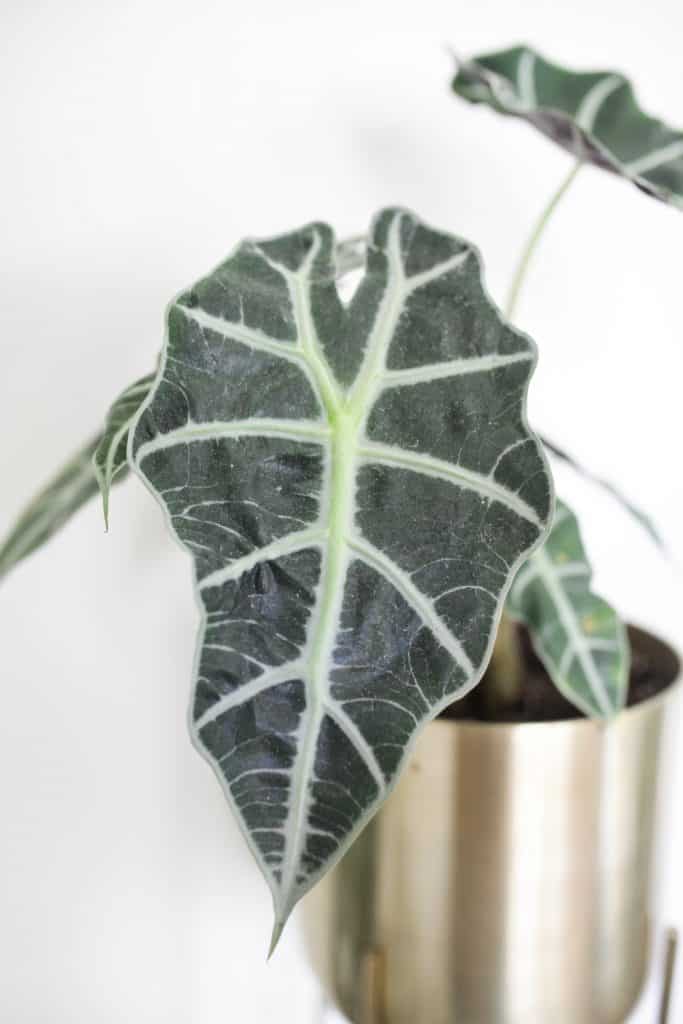
For those who are new plant owners, you need to make sure that your soil for this plant is always moist. This will help ensure that your plant is healthy and prevent you from having to take other steps to revive a plant that’s fallen into poor health.
Fertilizer
When it comes to fertilizer, these plants are definitely heavy feeders. The best way to help feed these plants is through a liquid fertilizer during the growing season or using frequent but small applications of a granule fertilizer. You can dilute an all purpose fertilizer into water, (I own and use this fertilizer) which can help you keep your plant moist and feed it appropriately.
Additionally, you can choose to have granules, which can be mixed together with potting soil. However, these are commonly used with outdoor gardens and are not used in houseplants as often. It can be hard to control how much of the nutrients come out of these granules as well, which is why many people just stick with liquid fertilizer.
Toxicity
Elephant’s Ear is a beautiful plant that offers a lot of color and vibrancy, but it is incredibly toxic to humans and to pets. People should be careful about letting their children or their pets near these plants, because ingesting this plant will result in an emergency.
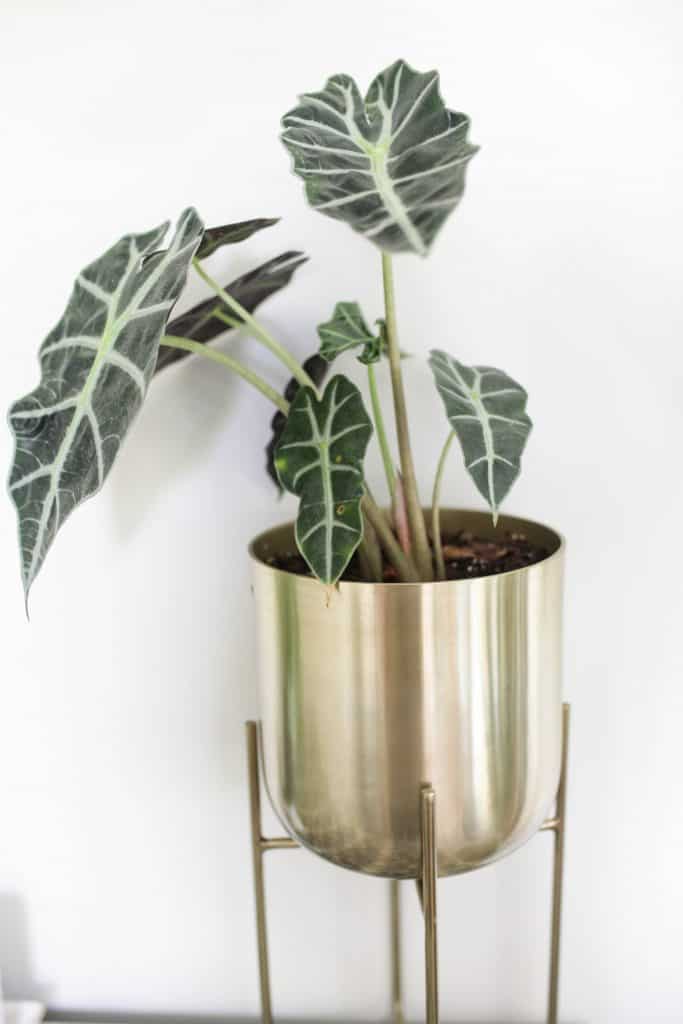
This plant is considered a very poisonous plant and it contains insoluble oxalate crystals. If a human or pet chews or even bites on the leave, the crystals will be released. This causes swelling and irritation in the mouth and even your GI tract. In very rare situations, there is an extreme swelling of the airway that will result in a difficulty to breathe.
If any of this happens, please contact poison control, your doctor, or your veterinarian, to make sure that this is handled quickly.
Pests and Diseases
If you’re thinking of getting an Alocasia plant, you also need to consider some of the common pests and diseases that this plant can have. Some of the more concerning diseases affect the crown, stem, route, and leaves.
Alocasia is incredibly sensitive, and this is a problem for pests and diseases. Some of the signs of diseases, specifically a Xanthomonas infection, include brown spots on the leaves and a yellowish rim around the spots.
The best way to avoid these diseases is to provide proper watering and proper air circulation.
There are also common pests included with this plant such as mealybugs, scale, aphids, and spider mites. To make sure that this plant is pest-free, spray the plant with warm soapy water. If you get an infestation, use ultrafine insecticide oil. This will kill any pests that you find and eliminate the situation.
We hope this post helped you learn how to take care of your Elephant’s Ear! Let us know in the comments if you have Alocasia in your home and how large your plant has grown!
Find even more big leaf plants here!

